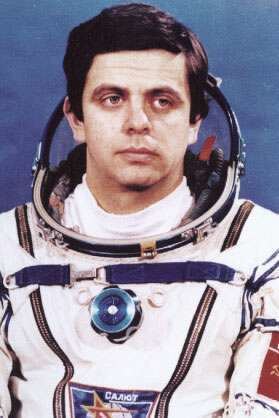Vladimir Solovyov
Russian - (RFSA)
Retired
Date of Birth: Nov. 11, 1946
Age: 79
Vladimir Alekseyevich Solovyov (Russian: Влади́мир Алексе́евич Соловьёв; born 11 November 1946) is a former Soviet cosmonaut. He was selected as a cosmonaut on 1 December 1978 and flew as Flight Engineer on Soyuz T-10 and Soyuz T-15, spending a total of 361 days, 22 hours, 49 minutes in space. His first flight, Soyuz T-10, took off on 8 February 1984, to join Salyut 7. The crew spent ten months (nearly 237 days) performing numerous medical and space manufacturing experiments. They came down aboard Soyuz T-11 on 2 October 1984. Solovyov's second flight was aboard Soyuz T-15, taking off on 13 March 1986 and coming back aboard the same craft on 16 July 1986, 125 days later. During the T-15 mission, the crew transferred equipment from Salyut-7 to the new Mir space station; they were the last aboard the former and the first aboard the latter.
Soyuz-U | Soyuz T-10
Russian Federal Space Agency (ROSCOSMOS) | RussiaBaikonur Cosmodrome, Republic of Kazakhstan
Feb. 8, 1984, 12:07 p.m.
Status: Success
Mission:
Soyuz T-10 was the third long-duration expedition to the Salyut 7 space station. The mission began on 8 February 1984, 12:07:26 UTC, launching Commander Leonid Kizim, Flight Engineer Vladimir Solovyov and Research Cosmonaut Oleg Atkov into orbit. They docked with the station the next day. During their 237-day stay on the station, crew performed various scientific and medical experiments, performed six EVAs for station maintenance, and were visited by Soyuz T-11 and Soyuz T-12 missions. Soyuz T-10, per usual, swapped vehicles with the Soyuz T-11 crew, which allowed for a longer stay on the station. The mission concluded with a safe landing back on Earth on October 2, 1984, 10:57:00 UTC.
Low Earth OrbitSoyuz-U | Soyuz T-11
Russian Federal Space Agency (ROSCOSMOS) | RussiaBaikonur Cosmodrome, Republic of Kazakhstan
April 3, 1984, 1:08 p.m.
Status: Success
Mission:
Soyuz T-11 was the sixth mission to visit the Salyut 7 space station and the first to visit the long-duration Soyuz T-10 resident crew of the station. The mission began on April 3, 1984, 13:08:00 UTC, launching Commander Yury Malyshev, Flight Engineer Gennady Strekalov and Research Cosmonaut Rakesh Sharma, the first Indian cosmonaut, into orbit. They docked with the station the next day. During their 7-day stay on the station, crew performed various scientific experiments. Soyuz T-11, per usual, swapped their vehicles with the resident Soyuz T-10 crew, which allowed for a longer stay on the station. The crew returned in Soyuz T-11 spacecraft, landing safely back on Earth on October 2, 1984, 10:57:00 UTC.
Low Earth OrbitSoyuz-U2 | Soyuz T-15
Soviet Space Program | RussiaBaikonur Cosmodrome, Republic of Kazakhstan
March 13, 1986, 12:33 p.m.
Status: Success
Mission:
Soyuz T-15 was the last mission to visit the Salyut 7 space station and the first to visit the Mir space station. The mission began on March 13, 1986, 12:33:09 UTC, launching Commander Leonid Kizim and Flight Engineer Volodimir Solovyov into orbit. They docked with Mir two days later. During their stay there, crew tested station's systems and were visited by two Progress cargo spacecrafts. On May 5, 1986, 12:12:09 UTC crew undocked from Mir and docked with Salyut the next day. There they collected experiments results, instruments and performed two EVAs. On June 25 crew undocked from Salyut 7 and returned to Mir the next day. The mission concluded with a safe landing back on Earth on July 16, 1986, 12:34:05 UTC.
Low Earth OrbitThe Roscosmos State Corporation for Space Activities, commonly known as Roscosmos, is the governmental body responsible for the space science program of the Russian Federation and general aerospace research. Soyuz has many launch locations the Russian sites are Baikonur, Plesetsk and Vostochny however Ariane also purchases the vehicle and launches it from French Guiana.
Falcon 9
Starlink Group 6-88
Space Launch Complex 40 - Cape Canaveral SFS, FL, USAA batch of 29 satellites for the Starlink mega-constellation - SpaceX's project for space-based Internet communication system.
Falcon 9
CSG-3
Space Launch Complex 4E - Vandenberg SFB, CA, USACSG-3 is an Earth observation satellite for the Italian Space Agency, part of a reconnaissance constellation using synthetic aperture radars operatin…
Long March 7A
Shijian 29 A-B
201 - Wenchang Space Launch Site, People's Republic of China2 satellites officially described as for "demonstration of new technologies for spatial targets detection" purposes.
Long March 4B
Tianhui 7
Launch Area 94 (SLS-2 / 603) - Jiuquan Satellite Launch Center, People's Republic of ChinaA satellite officially described as for cartography purposes, details TBD.
Soyuz 2.1b/Fregat-M
AIST-2T 01 & 02
Cosmodrome Site 1S - Vostochny Cosmodrome, Siberia, Russian FederationA pair of Russian optical Earth observation satellites built by the Progress Rocket Space Centre for obtaining stereo images of the Earth's surface, …




